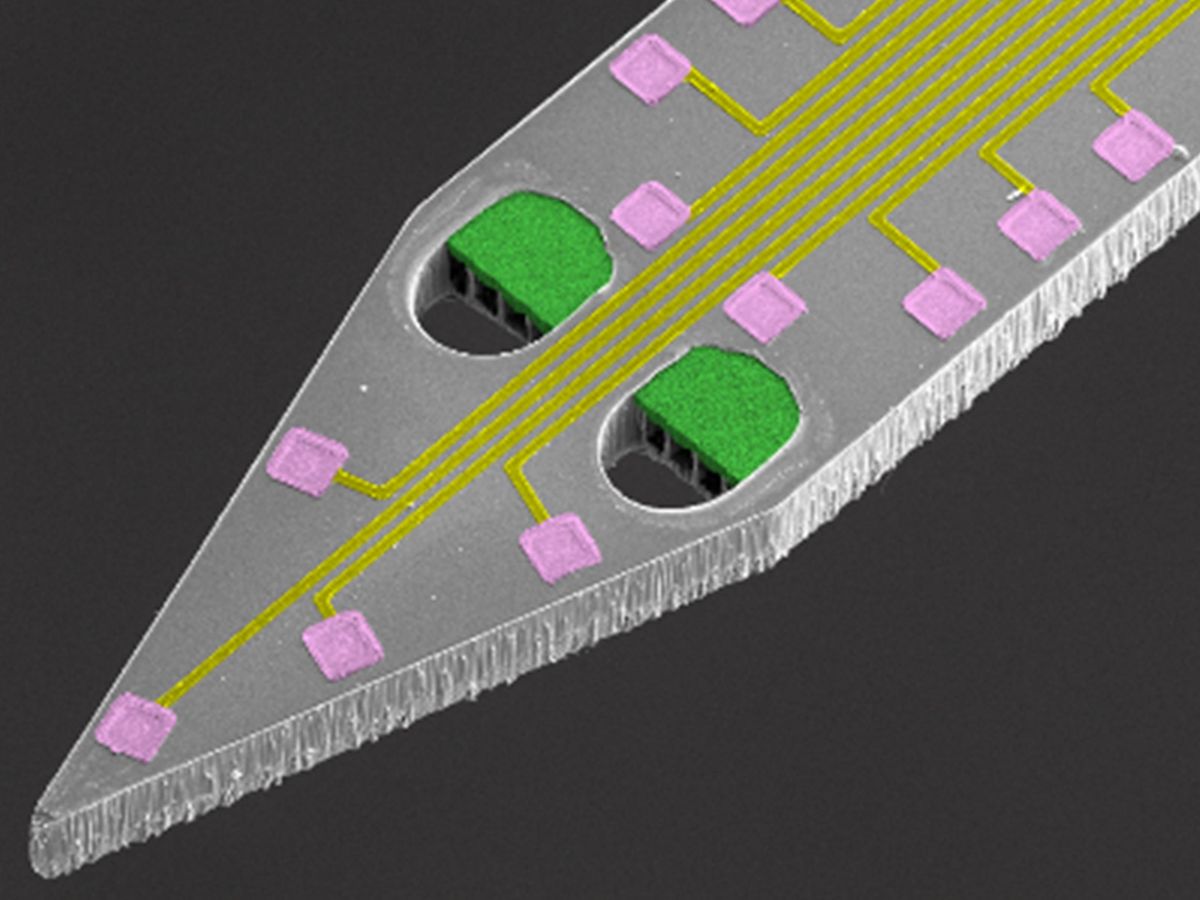Neurons use electrical pulses and chemicals to communicate with each other. Analyzing both is critical for studying brain function and spotting brain diseases, but today’s implants can measure only one or the other.
Researchers in Korea have now made a multifunctional chip that can measure both electrical charges and neurochemicals in the brain, and can also inject drugs in real time. They tested the chip, which is smaller than a U.S. quarter-dollar coin, in live mice.
“I expect our novel technology to provide opportunities for a variety of studies for the in-depth study of brain functions as well as for the investigation of neural circuits related to brain diseases,” says Il-Joo Cho of the Korea Institute of Science and Technology’s Brain Science Institute.
Measuring the concentration of neurotransmitters, the chemicals that transmit signals between neurons, can give pivotal insights into brain function, Cho says. People with Parkinson’s disease, for instance, have lower levels of serotonin, dopamine, and other neurotransmitters than normal. And in schizophrenia, neurons that release dopamine are much more active than in a typical brain.
But measuring these neurotransmitter levels today requires inserting a probe with a fluidic channel into the brain to collect brain fluid, which is analyzed using techniques like spectroscopy. That’s slow, and the millimeter-wide probes can cause tissue damage.
Recording the brain’s electrical signals is more straightforward. It can be done using ultrathin flexible polymer-based neural probes implanted in target brain regions, or metal electrodes attached to the scalp.
Scientists over the years have built brain implants that can measure the brain’s electrical signals to predict epileptic seizures, measure pH to determine and adjust dopamine levels, and they've seen some success with small, electrically controlled, pump-like devices that rapidly deliver neurotransmitters to the brain where needed.
But devices that can simultaneously measure electrical and neurochemical signals are hard to come by. One group recently reported tiny MEMS-based sampling devices that can collect extracellular fluid without damaging tissue, but these devices cannot record electrical signals.
Deciphering the quantitative relationships between those two signals in vivo would be valuable for neuroscience studies, Cho says. For example, it would allow neuroscientists to investigate the effect of drugs on the activities of specific types of brain cells. This has previously only been possible by analyzing brain slices, he says.
Cho says theirs is the first device capable of measuring electrical and chemical signals from the same area of the brain in a live animal. The device has a probe patterned with an array of twelve electrodes for recording electrical signals, and two in-built microfluidic channels to collect brain fluid.
The probe is only 40 micrometers thick, and has a cross-sectional area that is one-third or even one-fourth the girth of previously made probes—which minimizes tissue damage during insertion into the brain. The device also has a microfluidic interface chip attached to the probe for delivering drugs to the site.
In experiments on live mice, Cho and his colleagues delivered drugs to modulate the neural circuits in a targeted brain region. They observed changes in electrical signals in real time, and measured neurotransmitter levels in brain fluid samples taken every 20 minutes.
When they injected a potassium chloride solution, which is known to excite neurons, electrical signals fired at a much faster rate and concentrations of two neurotransmitters also increased significantly. The opposite happened when they injected an inhibitory drug that is known to suppress neural circuits. The researchers presented their device and experimental results in the journal Biosensors and Bioelectronics.
Cho says that the team now plans to add a real-time neurotransmitter monitoring ability. That should let them assess the correlation between electrical and chemical signals in real time.
- How Do Neural Implants Work? - IEEE Spectrum ›
- Vagus Nerve Stimulation Succeeds in Long-Term Stroke Recovery ... ›
- Implant Fights Stroke, Tinnitus by Retraining the Brain - IEEE Spectrum ›
- Implantable Chip Measures and Adjusts Dopamine Levels in Mouse ... ›
- Microfluidics Enhances AI Chip Performance - IEEE Spectrum ›
Prachi Patel is a freelance journalist based in Pittsburgh. She writes about energy, biotechnology, materials science, nanotechnology, and computing.



